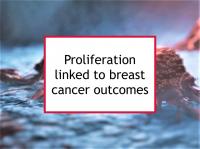Ki-67 (or Ki67) is used as a measure of the proliferative activity of breast cancer cells. Ki-67 is an antigen, a substance that causes the immune system to produce antibodies against it. It is a protein found only in growing, dividing cells (and not in cells in the resting phase of the cell growth cycle). See also Ki-67-based recurrence data.
Ki-67 normally can be found on breast cancer pathology reports. While there is some disagreement as to the usefulness of Ki-67 as a prognostic indicator, recent research has clarified the circumstances under which it can provide additional information concerning likely breast cancer outcomes.
High Ki-67 is associated with poor breast cancer prognosis
Although it is apparent that Ki-67 has an important role in cell division, its exact function is still not understood. Nevertheless, it appears to be a useful measure of proliferation. High Ki-67 is defined variously by different researchers.
Generally speaking, Ki-67 levels over 14% to 25% are considered high (depending on breast cancer and biopsy type) whereas levels over 40% are considered very high. High Ki-67 has been linked to unfavorable breast cancer outcomes in numerous breast cancer studies.
Ki-67 provides information beyond other prognostic indicators
Ki-67 provides prognostic information in addition to that given by tumor size, grade, hormone receptor status and number of positive lymph nodes. For example, tumors of a given size and low Ki-67 have a better prognosis than tumors of the same size and high Ki-67.
Ki-67 can help decide who should have post-mastectomy radiation
The question of which breast cancer patients should receive radiotherapy after a mastectomy is not settled. While using radiation can potentially improve prognosis in some women, the side effects associated with radiotherapy should be avoided, if possible. One study has suggested that women with Ki-67 over 20% should receive postmastectomy radiation treatment even if they have negative axillary lymph nodes. This is based on the finding that risk of locoregional recurrence was more than four times higher for tumors with Ki67 > 20% than lower proliferation levels. In fact, Ki-67 was the only independent prognostic factor studied that was found to be associated with such relapse in node negative women.
High Ki-67 predicts progression of DCIS and LCIS to invasive disease
Ductal carcinoma in situ (DCIS) and lobular carcinoma in situ (LCIS) are non-invasive states that might progress to invasive cancer. However, the majority of women with DCIS or LCIS will not develop invasive breast cancer, suggesting that some women could avoid treatment. Unfortunately researchers are not far along in identifying factors that predict progression, which could inform treatment recommendations. Ki-67 appears to be a prognostic indicator for the progression of both of these types of noninvasive disease.
High Ki-67 can identify ER+ chemotherapy candidates
While women with small, lymph node negative, estrogen receptor positive (ER+) tumors generally have a very favorable prognosis, some do relapse. Ki-67 can help determine which of these women might benefit from chemotherapy.
Changes in Ki-67 can measure effectiveness of treatment
The effectiveness of presurgical systemic treatments can be evaluated by comparing Ki-67 levels before treatment (in the biopsy tissue sample) and after breast cancer surgery.
Please see our article on breast cancer diet to reduce proliferation for information on foods and supplements that influence proliferation. Below are links to 20 recent studies concerning proliferation. For a more complete list of studies, please click on Ki-67.
